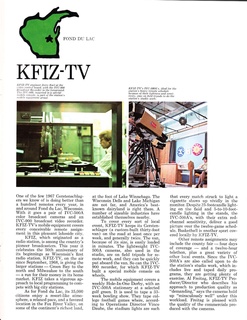A television network or broadcaster is a telecommunications network for distribution of television program content, whereby a central operation provides programming to many television stations or pay television providers. Until the mid-1980s, television programming in most countries of the world was dominated by a small number of terrestrial networks. Many early television networks evolved from earlier radio networks.

Kinescope, shortened to kine, also known as telerecording in Britain, is a recording of a television program on motion picture film, directly through a lens focused on the screen of a video monitor. The process was pioneered during the 1940s for the preservation, re-broadcasting and sale of television programmes before the introduction of videotape, which from 1956 eventually superseded the use of kinescopes for all of these purposes. Kinescopes were the only practical way to preserve live television broadcasts prior to videotape.

WUTV, virtual channel 29, is a Fox-affiliated television station licensed to Buffalo, New York, United States. The station is owned by the Sinclair Broadcast Group, as part of a duopoly with MyNetworkTV affiliate WNYO-TV. The two stations share studios on Hertel Avenue near Military Road in Buffalo; WUTV's transmitter is located on Whitehaven Road in Grand Island, New York.

WOWT, virtual channel 6, is an NBC-affiliated television station licensed to Omaha, Nebraska, United States and also serving Council Bluffs, Iowa. The station is owned by Gray Television. WOWT's studios are located on Farnam Street near downtown Omaha, and its transmitter is located on a "tower farm" near North 72nd Street and Crown Point Avenue in north-central Omaha.
Superstation is a term in North American broadcasting that has several meanings. Commonly, a "superstation" is a form of distant signal, a broadcast television signal—usually a commercially licensed station—that is retransmitted via communications satellite or microwave relay to multichannel television providers over a broad area beyond its primary terrestrial signal range.

KFYR-TV, virtual channel 5, is a dual NBC/Fox-affiliated television station licensed to Bismarck, North Dakota, United States. The station is owned by Gray Television. KFYR-TV's studios are located on North 4th Street and East Broadway Avenue in downtown Bismarck, and its transmitter is located near St. Anthony, North Dakota. On cable, the station is available on Midcontinent Communications channel 7 in the Bismarck–Mandan area and channel 5 in most other areas. There is a high definition feed provided on Midco digital channel 607.

KETK-TV, virtual channel 56, is an NBC-affiliated television station serving Tyler and Longview, Texas, United States that is licensed to Jacksonville. The station is owned by Nexstar Media Group, which also operates Longview-licensed Fox affiliate KFXK-TV and Tyler-licensed low-power MyNetworkTV affiliate KTPN-LD under a shared services agreement (SSA) with owner White Knight Broadcasting. The three stations share studios on Richmond Road in Tyler; KETK's transmitter is located near FM 855 in unincorporated northwestern Cherokee County.

WAND, virtual channel 17, is an NBC-affiliated television station licensed to Decatur, Illinois, United States and serving the Central Illinois region. The station is owned by Block Communications. WAND's studios are located on South Side Drive in Decatur, and its transmitter is located along I-72, between Oreana and Argenta.

KVIA-TV, virtual channel 7, is a dual ABC/CW+-affiliated television station licensed to El Paso, Texas, United States and also serving Las Cruces, New Mexico. The station is owned by the St. Joseph, Missouri-based News-Press & Gazette Company. KVIA-TV's studios are located on Rio Bravo Street in northwest El Paso, and its transmitter is located atop the Franklin Mountains within the El Paso city limits.
WBNA, virtual channel 21, is an independent commercial television station licensed to Louisville, Kentucky, United States. The station is owned by local charismatic megachurch Evangel World Prayer Center. WBNA's offices are located on Fern Valley Road in Okolona, and its transmitter is located off Oakcrest Drive in Shepherdsville. As such, WBNA is the only full-power television station in the Louisville market whose transmitter facilities are not based at the Kentuckiana tower farm in Floyds Knobs, Indiana. On cable, the station is available on Charter Spectrum and Comcast Xfinity channel 21.

WKPT-TV, virtual channel 19, is a Cozi TV-affiliated television station licensed to Kingsport, Tennessee, United States, serving the Tri-Cities area of northeastern Tennessee and southwestern Virginia. Owned by the Glenwood Communications Corporation, it is sister to low-powered Class A MeTV affiliate WAPK-CD and several radio stations, including WKPT. All of the outlets share studios on Commerce Street in downtown Kingsport; WKPT-TV's transmitter is located on Holston Mountain in the Cherokee National Forest. On cable, WKPT-TV can be seen on Comcast Xfinity channel 9 and Charter Spectrum channel 6.

KTEN, virtual channel 10, is a NBC/CW+/ABC-affiliated television station licensed to Ada, Oklahoma, United States and serving the Ada–Sherman television market. The station is owned by Lockwood Broadcast Group. KTEN's primary studios are located on High Point Circle in northwestern Denison, Texas, with secondary studios at the Ardmore Energy Center on Merrick Drive in northwestern Ardmore, and business offices at the intersection of East Main Street and Rennie Avenue in downtown Ada, Oklahoma. The station's transmitter is located along State Highway 7 in rural northeastern Johnston County, Oklahoma.
WHSV-TV, virtual channel 3, is an ABC-affiliated television station licensed to Harrisonburg, Virginia, United States and serving the Shenandoah Valley of Virginia and West Virginia. Owned by Gray Television, it is sister to two low-powered stations: Class A dual Fox/CBS affiliate WSVF-CD and dual NBC/CW+ affiliate WSVW-LD. The three stations share studios on North Main Street in downtown Harrisonburg, and operate a newsroom in Fishersville, serving Staunton, Waynesboro, and Augusta County. WHSV-TV's transmitter is located at Elliott Knob west of Staunton.

KRBC-TV, virtual channel 9, is an NBC-affiliated television station licensed to Abilene, Texas, United States. The station is owned by Mission Broadcasting; Nexstar Media Group, which owns CBS affiliate KTAB-TV, operates KRBC under joint sales and shared services agreements (JSA/SSA). The two stations share studios on South 14th Street in western Abilene; KRBC-TV's transmitter is located on Texas State Highway 36 in neighboring Callahan County. There is no separate website for KRBC-TV; instead, it is integrated with that of sister station KTAB-TV.

WJJY-TV was a short-lived television station based in Jacksonville, Illinois that was on the air from 1969 to 1971. It was the ABC television affiliate for Quincy, Illinois, and also reached Springfield as well.
Frank Kyle Spain was an American inventor and television engineer. He is best known for founding and building WTVA, an NBC affiliate in Tupelo, Mississippi.

A broadcast relay station, also known as a satellite station, relay transmitter, broadcast translator (U.S.), re-broadcaster (Canada), repeater or complementary station (Mexico), is a broadcast transmitter which repeats the signal of a radio or television station to an area not covered by the originating station. It expands the broadcast range of a television or radio station beyond the primary signal's original coverage or improves service in the original coverage area. The stations may be used to create a single-frequency network. They may also be used by an AM or FM radio station to establish a presence on the other band.
WKNA-TV was a television station in Charleston, West Virginia that broadcast on UHF channel 49 from 1953 to 1955.

KFIZ-TV, UHF analog channel 34, was an independent television station licened to Fond du Lac, Wisconsin, United States that operated from August 1, 1968, to November 30, 1972. The station was a sister station to KFIZ-AM.
The scheduling of television programming in North America must cope with different time zones. The United States has six time zones, with further variation in the observance of daylight saving time. Canada also has about 6 time zones. Mexico has four time zones. This requires broadcast and pay television networks in each country to shift programs in time to show them in different regions.












